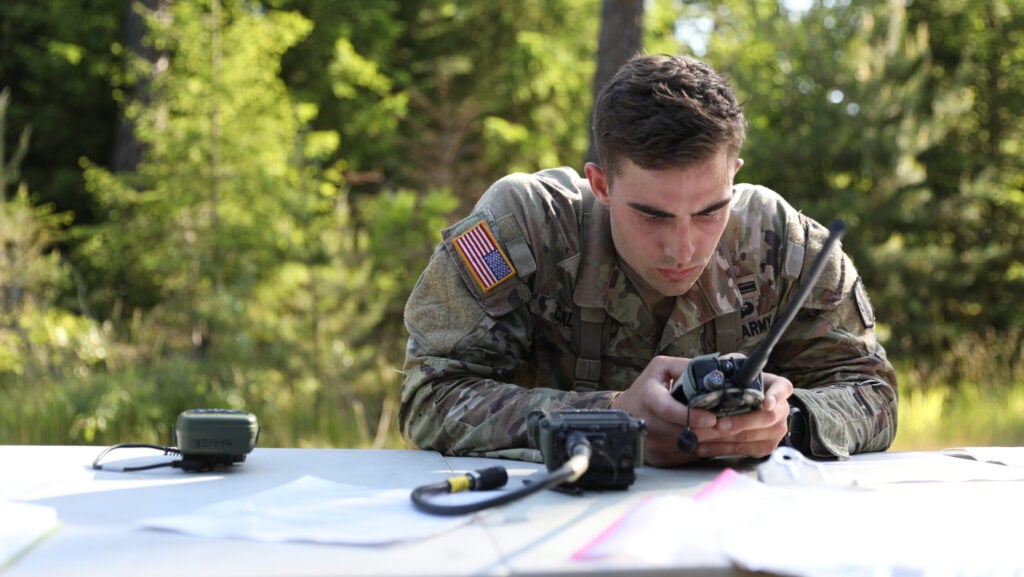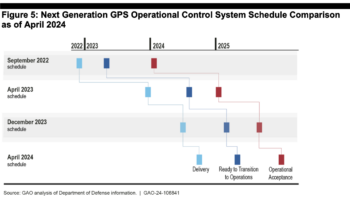
WASHINGTON — After nearly two decades in development, the Pentagon’s sprawling effort to make GPS signals harder to jam just cannot seem to get out from under delay upon delay across all segments — space, ground and user equipment — according to a new report by the Government Accountability Office (GAO).
“Many of the programs that are part of the GPS modernization effort had significant development challenges that resulted in cost overruns and years of delays to implementing M-code capability. These delays increase risk to the warfighter as adversaries continue to develop and field technology that can compromise GPS signals,” states the report, “GPS Modernization: Delays Continue in Delivering More Secure Capability for the Warfighter,” released today.
To make matters worse, according to the government watchdog, the Defense Department is now facing down a possible shortage of microchips and processor cards to allow ground vehicles, ships and aircraft to access GPS at all.
The Space Force is responsible for the space segment, and has made some progress in fixing “some technical and manufacturing challenges” in development of the GPS III and GPS IIIF satellites, designed to replace the older versions now operating, the GAO report says. But as a result of having to make those fixes, the service now is pushing up against the boundaries of its schedule. “Further delays could risk DOD’s goal to have 24 M-code-capable satellites in continuous operation through the 2030s,” the report says.

Likewise, the service is responsible for the new ground system for command and control of those satellites, called the Next-Generation Operational Control System (OCX). Being developed by RTX (formerly Raytheon), OCX is needed to allow some 700 weapon systems across the US military to fully access the M-code. However, the program has been a poster child for broken acquisition, having been originally planned to begin operations more than a decade ago — and its development continues to bedevil the Space Force, the GAO report says. While some key testing now has been completed, the service’s planned date for operational acceptance for OCX has now been pushed back to December 2025 from its most recent goal of July 2025, the report says, despite Raytheon having made some progress in its testing.

Air Force cyber resilience in focus
Cyber resilience has become a frontline mission for the US military. Breaking Defense’s new eBook rounds up key reporting from the 2025 Alamo ACE conference with the latest developments in cyber offense and defense.
The Space Force also is in charge of developing the microchips and microelectronics cards that interface with the M-code signals, although each individual service is responsible for building service-specific receivers/radios that use those components. DoD’s inability to field the M-code user kit, being developed under the Military User GPS Equipment (MGUE) program, has been one of the banes of the GPS program for more than two decades — as reported ad nauseam by GAO and the Pentagon’s Office of Test & Evaluation.
“While the Space Force has made progress in developing user equipment, significant risks remain to delivering capabilities to the warfighter. After years of delay, the first increment of user equipment—microchips and cards that process M-code signals—is approaching its final series of tests. However, discovery of additional deficiencies threatens the program’s schedule,” the new report finds.

The MGUE effort has two parts. MGUE Increment 1 is developing the baseline military-unique ASIC chips and cards for initial integration with Army Strykers and Marine Corps Joint Light Tactical Vehicles, as well as for the Air Force’s B-2 bombers and the Navy’s DDG-class destroyers. MGUE Increment 2 is developing a smaller, more powerful ASIC chip for use by handheld radios and precision-guided munitions, which “combines a series of commercial off-the-shelf designs with sensitive military functions to be added to the programming,” GAO explains.
Both efforts are still fraught with risks, the report finds.
“After years of delays, the Space Force’s MGUE Increment 1 program is approaching its final series of tests. However, discovery of additional deficiencies could add further risk to the program’s schedule. While two of the MGUE Increment 2 contractors have started critical design review for their receiver cards, the program is at risk of exceeding the 5-year time frame associated with programs using the middle tier of acquisition pathway,” GAO says.
Meanwhile, DoD’s Positioning, Navigation and Timing (PNT) Oversight Council is trying to figure out how to deal with “potential shortages of GPS chips and cards,” the report adds. “DOD is facing a potential gap in the availability of GPS receiver cards as some of the current cards can no longer be produced and the M-code-capable replacements have been delayed. In addition, Army officials stated that foreign military sales of GPS-enabled equipment to allies and foreign partners are also depleting the stock of cards.”
As for receiver development, GAO finds that the Army and Navy have made progress towards fielding, but the Air Force is seriously lagging.
“Due to development issues, the Air Force’s M-code GPS receivers are significantly delayed, pushing back fielding of M-code capability for multiple Air Force and Navy aviation platforms. To mitigate some of these delays, the Navy and Air Force are planning an interim solution that would provide M-code capability with some of their current receivers,” the report elaborates
“The Army is making progress with its ground vehicle, handheld, and aviation receivers, with plans to field them in platforms in fiscal years 2024 and 2025. The Navy is reliant on the Air Force to develop its air platform receivers, while its maritime receiver plans to complete operational testing in fiscal year 2025. Finally, the Marine Corps plans to leverage the Army’s M-code receiver for its ground vehicles and has not yet chosen an option for its new handheld GPS systems,” it adds.
The issue of M-Code handheld radios, however, highlights the difficulties the Pentagon has had in coordinating the service’s various efforts. The Space Force in July 2023 granted a contract to Technology Advancement Group to prototype a handheld using the planned MGUE Increment 2 chip and card, under a project estimated to cost $149.2 million in 2020, the GAO report says.
This is despite the fact that the largest customer for handheld GPS radios, the Army, has said it has no intentions of buying the Space Force receiver and is pursuing its own options including tapping commercial providers. The other key potential user, the Marine Corps, also has said it wants to have an open competition, according to the GAO report. Thus the watchdog agency last year recommended that given the lack of a “sound business case,” the Space Force simply drop the prototype.
The Pentagon “agreed with this recommendation but reported an award for the handheld receiver in July 2023 without having first established a sufficient business case. We therefore closed the recommendation as being no longer valid,” GAO stated.